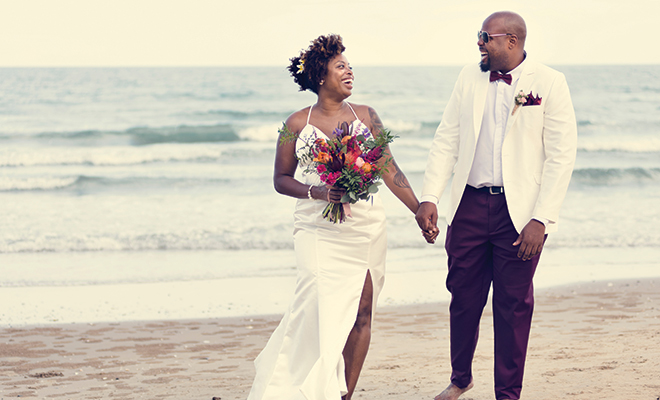
To Cover or Not to Cover?
Your wedding day is around the corner, and no matter how mainstream tattoos have become, there are still formal occasions when some women decide they want to cover them up.
What do you do when you have body art in noticeable spots, especially if your wedding gown makes them look even more prominent? If you’re on the fence about whether or not you should, or want to, cover your tattoos, there are some tips and recommendations to consider when planning your wedding day look.
While you might love your tattoos it’s possible you don’t want them to be as visible on your wedding day. Thankfully, there’s a solution; you can easily cover your tattoos with specially formulated products.
Working with a makeup artist who specializes in tattoo cover-ups is usually recommended; they’ll have professional products designed to last through the hours of celebrating. Depending on the location of your tattoo, you’ll want to keep in mind that sweating or rubbing against fabric could affect the quality of the cover-up, so go through your options with the makeup artist during the trial run of your wedding day look.
Is it a small tattoo that you want to cover yourself? Here are some basic tips to consider when shopping for quality products to cover tattoos on your own.
Look for concealer that’s waterproof. This is really important even if you don’t plan to get married during warmer months. With dancing, hugging and celebrating, you’ll find yourself warm and sweating or oily throughout the day, so you don’t want any mishaps with coverage. A concealer with silica is often recommended because it absorbs oil in the skin and stays put for hours.
Cleanse the skin thoroughly before you apply any product. To achieve full coverage, the skin should be prepped and excess oil needs to be removed so the product sticks seamlessly over the tattoo. Use any type of astringent that removes oil; a salicylic acid pad is really effective.
Apply concealer using a stippling-type application with a round cosmetic sponge. This allows you to create light layers that you can easily build upon to provide full, natural coverage. The number of layers you need will depend on a variety of factors such as color, size or location of the tattoo.
Next, you’ll want to set the concealer much as you would with face makeup. Use a puff to cover the concealer with a generous application of translucent powder. You’ll really want an excess dusting to start; allow it to sit on the skin and set for a good 15 to 20 minutes before you brush the excess powder away.
The final step will be to even out the concealer with your natural skin tone by using a foundation that matches your skin. An airbrush applicator is usually a good way to go because it creates a natural but full-coverage layer, but you can also use a makeup sponge and apply it the way you did initial layers of concealer. A foundation with silicone helps provide water resistance for a good amount of time. Follow up with another dusting of translucent powder and setting spray and you’ll be good to go! If you have larger tattoos or if they cover large areas of your body, such as a sleeve, it’s worth considering going to a professional who can provide gorgeous, long-lasting coverage without the worry.
On the other hand, if you’re still in the early planning stages of your wedding and you have tattoos you’ve long wanted to remove, this could be the perfect time to start the process. Spend time looking for the appropriately trained professional who can advise you about the best removal method for your skin. Laser treatment is the best option for scar-free removal.
During a laser procedure, laser light is applied to the tattooed area of the skin. The light is selectively absorbed by the ink particles, leaving the surrounding skin unharmed. The tattoo ink particles absorb the laser energy, heat up, and shatter into smaller particles. Over time, the body’s immune system flushes away the shattered ink particles, causing the tattoo to fade. With additional treatments, more of the ink shatters, leaving the skin free of ink.
Give yourself plenty of time. Depending on the color, complexity of design or location, it could take multiple sessions plus a recovery period between each session, so start the process as soon as you can. Consider lightening only. If you don’t have time or desire to go for a full tattoo removal, then lightening for easier future coverage can be an alternative option.
Don’t let your tattoos keep you from enjoying your wedding day to the fullest! There are many options to help you cover or conceal body art for the big day. ■
Sources: theknot.com, glamour.com, weddingwire.com and webmd.com.







